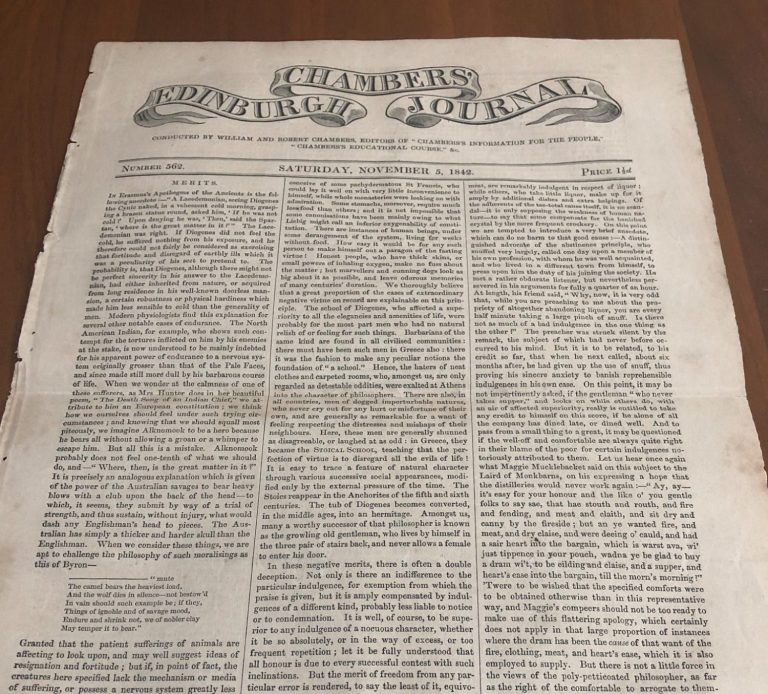
The Greek Psalter
Chambers' Edinburgh Journal
5 November, 1842
Mormonism.
The sect of the Mormonites, or Latter-Day Saints, has of late years become familiar by these names in Great Britain. They derived their first and standing appellation from a work called the Book of Mormon, assumed by them to be the fruit of inspiration and revelation, and taken as the text-book and Bible of the sect. The Book of Mormon, published two or three times in North America, and once in Britain in 1841, had the following origin:-
Some twenty and odd years since, a young man named Joseph Smith, the founder, apostle, and prophet of the Mormonites, followed the profession ofa money-digger in the United States. It is a common believe in some of the maritime districts of that republic, that large sums of money and masses of bullion were there buried in the earth by the buccaneers, as well as, more recently, by persons concerned in the Revolution. The pretence of discoveing these treasures by incantations was an artificie to which needy and cunning men frequently resorted, distinguished himself peculiarly in this line. While he was engaged in these and similar pursuits, he received, as his own story runs, several revelations from heaven, relative to the religiouis sects of the day. On the first occasion when he was thus favored, he had gone into a grove, and there besought divine aid to show him which, of all the denominations of the Christian church then existing, he ought to reverence and follow as the true one. A bright light, he said, appeared above his head; he was recieved up into the midst of it; and he there saw two angelic personages, who told him that all his sins were forgiven, that the whole world was in error on religious points, and that the truth shoudl be made known to him in due time. A second revelation of a similar description informed Smith that the American Indians were a remnant of the children of Israel, and that prophets and inspired men had once existed emong them, by whom divine records had been deposited in a secure place, to save them from the hands of the wicked. A third communication, made on the morning of September 22, 1823, informed Smith that these relics were to be found in a cavern, on a large hill to the east of the mail-road from Palmyra, Wayne county, state of New York.
From beginning to end, this work is filled with evidences of forgery and imposture. The peculiarj style of holy writ is borrowed throughout, and, as regards words and names, many spearate languages are drawn upon, proving the assumed writer of early ages to have all the information of our day before him. The
It might be deemed superfluous to say so much on this subject , were it not that the Mormon delusion has spread widely in North America, and even in Great Britain. Joseph Smith and his colleagues settled in 1831 on the Missouri, whence they were soon after expelled on account of their lawless conduct. They then went to Illinois, and founded a town or city, called Nauvoo, near the Mississippi, said now to contain 1700 able bodied men, exclusive of women and children. To this place too many emigrants are directing their course even from Great Britain. What sort of people they will find in the persons of the prophet and his associates, appears very clearly from a little work by Mr. Caswall, who visited the city of the Mormons in the present year (1842). THe following is his picture of Joseph Smith :-
“I met Joseph Smith at a short distance from his dwelling, and was introduced to him. I had the honour of an interview with him who is a prophet, a seer, a merchant, a ‘revelator,’ an elder, an editor, and the general of the ‘Nauvoo legion.’ He is a coarse plebeian person in aspect, and his countenance exhibits a curious mixture of the knave and the clown. His hands are large and fat, and on one of his fingers he wears a massive gold ring, upon which I saw an inscription. His dress was of coarse country manufacture, and his white hat was enveloped by a piece of black crape as a sign of mourning for his deceased brother, Don Carlos Smith, the late editor of the ‘Times and Seasons.’ His age is about thirty-five. I had an opportunity of observing his eyes, as he appears deficient in that open straightforward look which characterizes an honest man. He led the way to his house, accompanied by a host of elders, bishops, preachers, and common Mormons. On entering the house, chairs were provided for the prophet and myself, while the curious and gaping crowd remained standing.
I handed a book to the prophet, and begged him to explain its contents. He asked me if I had any idea of its meaning. I replied, that I believed it to be a Greek Psalter, but that I should like to hear his opinion. ‘No,’ he said; ‘it ain’t Greek at all, except, perhaps,a few words. What ain’t Greet is Egyptian, and what ain’t Egyptian is Greek. This book is very valuable. It is a dictionary of Egyptian hieroglyphics.’ Pointing to the capital letters at teh commencement of each verse, he said, ‘Them figures is Egyptian hieroglyphics, and them which follows is the interpretation of the hieroglyphics, written in the reformed Egyptian. Them characters is like the letters that was engraved on the golden plates.’ Upon this the Mormons around began to congratulate me on the information I was receiving. ‘There,’ they said, ‘we told you so –we told you that our prophet would give you satisfaction. None but our prophet can explain these mysteries.’” The error of taking a Greek Psalter for a specimen of Egyptian hieroglyphics, sufficiently proves the slender pretensions of Mr. Joseph Smith to be a myster-expounder.